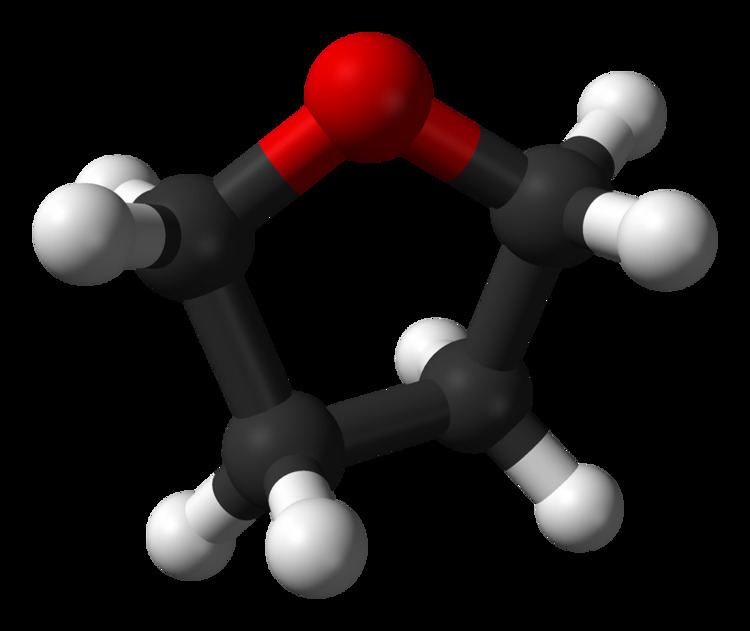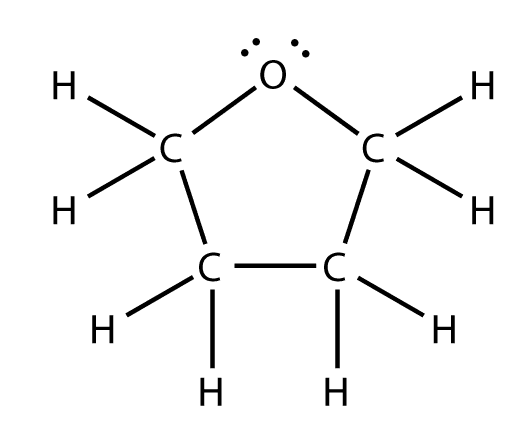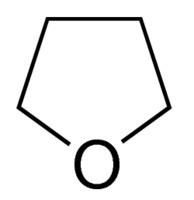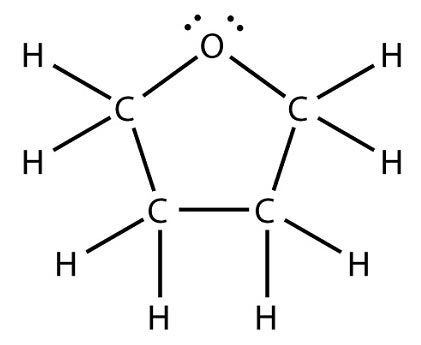Abbreviations THF Related compounds Density 889 kg/m³ Molar mass 72.11 g/mol Melting point -108.4 °C | Appearance colorless liquid Boiling point 66 °C Formula C4H8O IUPAC ID Oxolane | |
 | ||
Thermodynamicdata Phase behavioursolid–liquid–gas | ||
Tetrahydrofuran (THF), whose Preferred IUPAC name was changed in 2013 to oxolane, is an organic compound with the formula (CH2)4O. The compound is classified as heterocyclic compound, specifically a cyclic ether. It is a colorless, water-miscible organic liquid with low viscosity. It is mainly used as a precursor to polymers. Being polar and having a wide liquid range, THF is a versatile solvent.
Contents
- Tetrahydrofuran
- Production
- Other methods
- Polymerization
- As a solvent
- Purification
- Potential uses and research
- Other uses
- 2 MethylTHF
- Precautions
- References

Tetrahydrofuran
Production

About 200,000 tonnes of tetrahydrofuran are produced annually. The most widely used industrial process involves the acid-catalyzed dehydration of 1,4-butanediol. Ashland/ISP is one the biggest producers of this chemical route. The method is similar to the production of diethyl ether from ethanol. The butanediol is derived from condensation of acetylene with formaldehyde followed by hydrogenation. DuPont developed a process for producing THF by oxidizing n-butane to crude maleic anhydride, followed by catalytic hydrogenation. A third major industrial route entails hydroformylation of allyl alcohol followed by hydrogenation to the butanediol.
Other methods

THF can also be synthesized by catalytic hydrogenation of furan. certain sugars can be converted to THF, although this method is not widely practiced. Furan is thus derivable from renewable resources.
Polymerization

In the presence of strong acids, THF converts to a linear polymer called poly(tetramethylene ether) glycol (PTMEG), also known as polytetramethylene oxide (PTMO):
n C4H8O → −(CH2CH2CH2CH2O)n−This polymer is primarily used to make elastomeric polyurethane fibers like Spandex.
As a solvent
The other main application of THF is as an industrial solvent for polyvinyl chloride (PVC) and in varnishes. It is an aprotic solvent with a dielectric constant of 7.6. It is a moderately polar solvent and can dissolve a wide range of nonpolar and polar chemical compounds. THF is water-miscible and can form solid clathrate hydrate structures with water at low temperatures.

In the laboratory, THF is a popular solvent when its water miscibility is not an issue. It is more basic than Diethyl ether and forms stronger complexes with Li++, Mg2+, and boranes. It is a popular solvent for hydroboration reactions and for organometallic compounds such as organolithium and Grignard reagents. Although similar to diethyl ether, THF is a stronger base. Thus, while diethyl ether remains the solvent of choice for some reactions (e.g., Grignard reactions), THF fills that role in many others, where strong coordination is desirable and the precise properties of ethereal solvents such as these (alone and in mixtures and at various temperatures) allows fine-tuning modern chemical reactions.
Purification
Commercial THF contains substantial water that must be removed for sensitive operations, e.g. those involving organometallic compounds. Although THF is traditionally dried by distillation from an aggressive desiccant, molecular sieves are far superior.
Potential uses and research
THF has been explored as a miscible co-solvent in aqueous solution to aid in the liquefaction and delignification of plant lignocellulosic biomass for production of renewable platform chemicals and sugars as potential precursors to biofuels. Aqueous THF augments the hydrolysis of glycans from biomass and dissolves the majority of biomass lignin making it a suitable solvent for biomass pretreatment.
THF is often used in polymer science. For example, it can be used to dissolve polymers prior to determining their molecular mass using gel permeation chromatography. THF dissolves PVC as well, and thus it is the main ingredient in PVC adhesives. It can be used to liquefy old PVC cement and is often used industrially to degrease metal parts.
THF is used as a component in mobile phases for reversed-phase liquid chromatography. It has a greater elution strength than methanol or acetonitrile, but is less commonly used than these solvents.
Other uses
THF is also a starting material for the preparation of tetrahydrothiophene. In the presence of a solid acid catalyst, it reacts with hydrogen sulfide.
THF is used as a solvent in 3D printing when using PLA plastics. It can be used to clean clogged 3D printer parts, as well as when finishing prints to remove extruder lines and add a shine to the finished product.
2-MethylTHF
2-Methyltetrahydrofuran (2-MeTHF) has been promoted as a more ecologically-friendly alternative to THF. Whereas 2-MeTHF is more expensive, it may provide for greater overall process economy. 2-MeTHF has solvating properties that are intermediate between diethyl ether and THF, has limited water miscibility, and forms an azeotrope with water on distillation. Its lower Melting point makes it useful for lower temperature reactions, and its higher Boiling point allows procedures under reflux at higher temperatures (relative to THF).
Precautions
THF is considered a relatively nontoxic solvent, with the median lethal dose (LD50) comparable to that for acetone. Reflecting its remarkable solvent properties, it penetrates the skin, causing rapid dehydration. THF readily dissolves latex and is typically handled with nitrile or neoprene rubber gloves. It is highly flammable.
One danger posed by THF follows from its tendency to form highly explosive peroxides on storage in air.
To minimize this problem, commercial samples of THF are often inhibited with butylated hydroxytoluene (BHT). THF should not be distilled to dryness, because the explosive peroxides concentrate in the residue.
